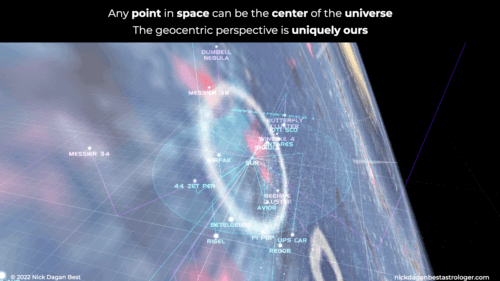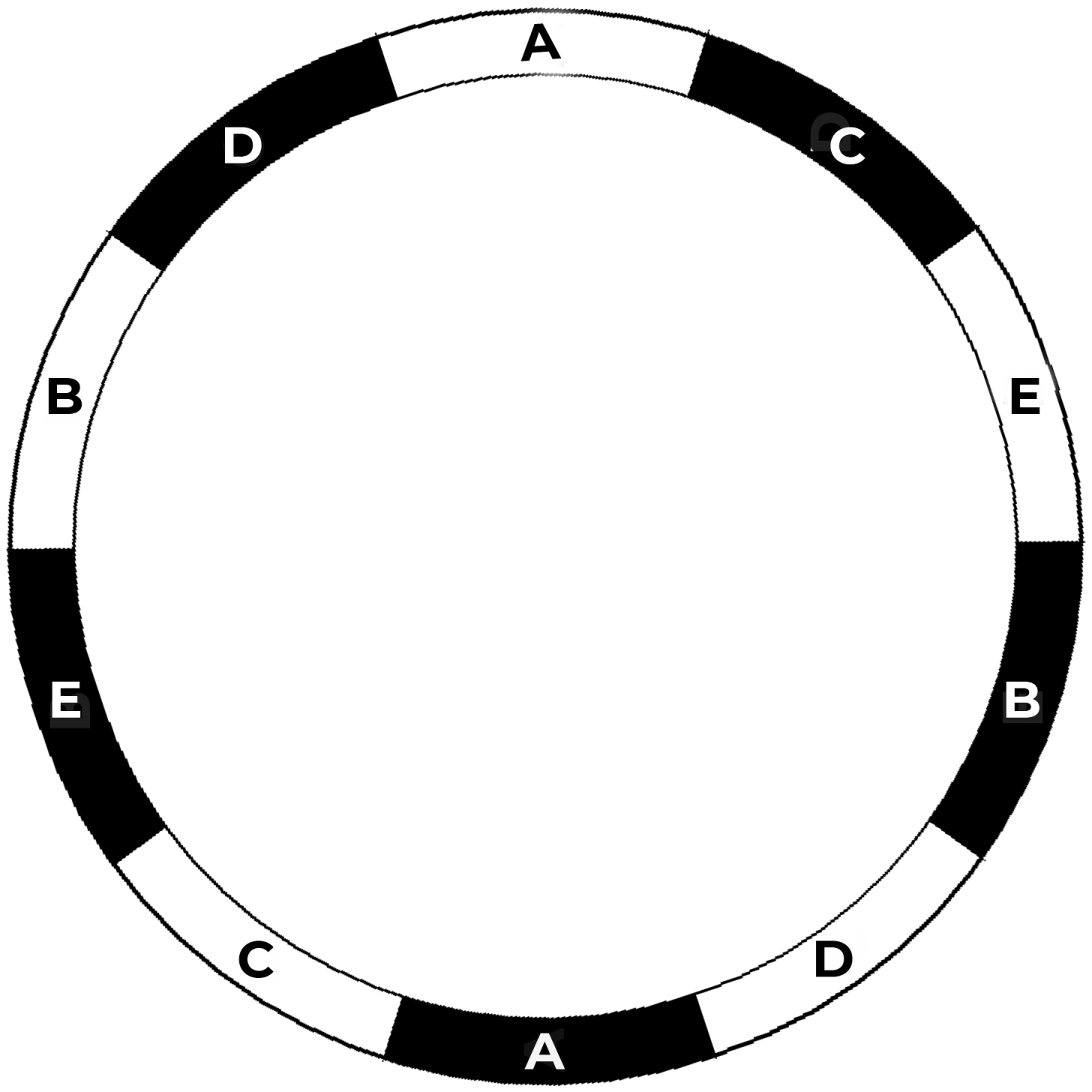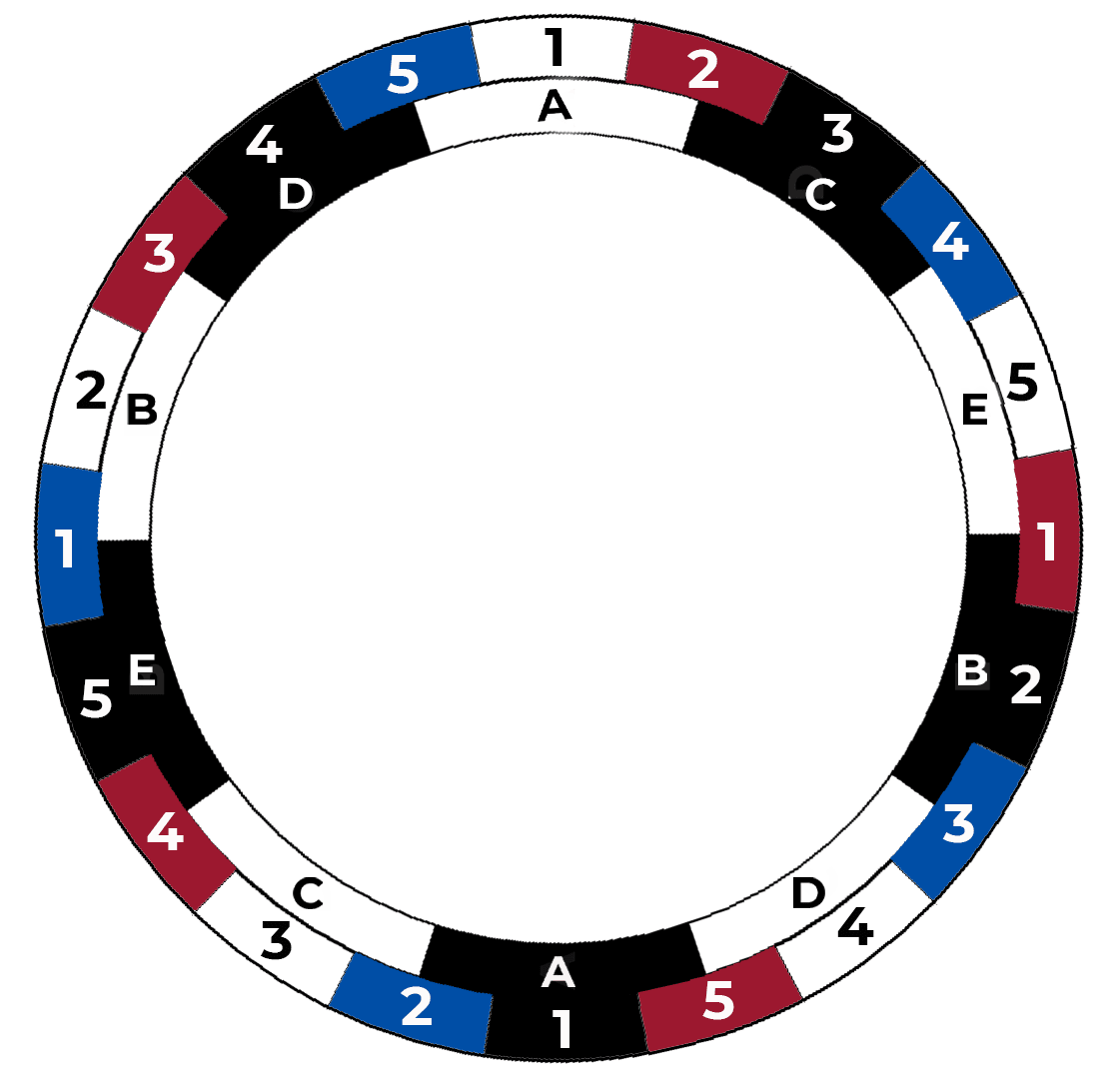Introduction to the Venus Synodic Cycle
Imagine a circle
Audio, transcript, and images from video
Imagine a circle.
Imagine the circle represents 2920 days.
Divide the circle into ten equal parts.
Split these parts into alternating black and white sections, and voila, you have reproduced the elegantly simple outline of the Venus synodic cycle.
Venus is the brightest light in the sky after the Sun and Moon.
The Venus synodic cycle is an eight-year pattern defined relative to the annual solar cycle.
Synod is derived from the Greek synodos for meeting place.
It refers to a cyclical relationship between two bodies.
Astrology is a complex calendar system.
It can be used to study human life according to a measurement of time.
It tells the combined biographies of billions of souls.
Astrological study of the Venus synodic cycle goes back at least to the Babylonian era, Second to First Millennia BCE.
This knowledge predates the creation of horoscopic astrology and is likely to have contributed to its design.
The practice of astrology involves observing the movements of planets.
Planetary positions are calculated according to a geocentric model.
Any point in space can be the center of the universe.
The geocentric perspective is uniquely ours.
Phases
Earth orbits the Sun at a different rate than other planets.
Venus is closer to the Sun than Earth, giving it a shorter orbit.
One full cycle of its transit path passes both in front of and behind the Sun.
Sun-Venus exterior conjunctions occur when Venus is at its greatest distance from Earth on the opposite side of the Sun.
Sun-Venus interior conjunctions occur when Venus is closest to Earth, between Earth and the Sun.
The phase circle defines the Venus synodic cycle by the binary of rising and setting phases.
Rising phases begin following an interior conjunction.
Venus rises in the east before sunrise.
Setting phases begin following an exterior conjunction.
Venus sets in the west following sunset.
The Venus synodic cycle is a natural work of near-perfect celestial symmetry.
It traces the outline of humanity's most universal symbol: the five-pointed star.
Within one complete 2920-day synodic cycle Venus shifts 10 times between rising and setting phases, at an average of once every 292 days.
Since the Venus synodic cycle is two days shy of an exact eight-year solar cycle, its return completes two to three calendar days and two to three zodiacal degrees earlier than the previous return.
The five tropical signs were Venus rising and setting phases begin will shift backward into the preceding sign once every 120 years.
It takes 251 years for exterior and interior conjunctions to recur at the same tropical zodiacal degrees.
Intervals
The 2920-day Venus synodic cycle can also be divided into 20 parts averaging 146 days each.
To define our 20 intervals we start by dividing the cycle into four groups: red, white, blue, and black.
Note that the interval circle places the exterior conjunction at the center of the Blue intervals and the interior conjunction at the center of the Red intervals.
The Red and Blue intervals are each exactly 146 days long, measured 73 days on either side of their respective interior and exterior conjunctions.
The Red intervals begin within a day of Venus being furthest from the Sun at its greatest Western elongation prior to slowing down toward retrograde motion.
The Red intervals end within a day of Venus's greatest Eastern elongation following the direct station and its emergence as a Morning Star.
The phases are divided according to rising and setting conditions.
The intervals are divided according to shifting planetary speed.
The White intervals last an average of 146 days.
This is Venus is a morning star gradually accelerating towards its exterior conjunction.
Blue intervals last exactly 146 days.
This is Venus shifting from a rising to setting phase moving in fast direct motion with the exterior conjunction at the center of the interval.
Black intervals last an average of 146 days.
This is Venus as an evening star gradually slowing down towards retrograde motion.
Red intervals last exactly 146 days.
This is Venus shifting from a setting to rising phase moving in slow retrograde motion with the interior conjunction at the center of the interval.
Phases and intervals
White 1 Rising A: The White 1 interval begins with Venus in tropical Sagittarius just past its greatest Eastern elongation as it accelerates towards the Sun in Capricorn.
Blue 5 Rising A: The Blue 5 interval begins with Venus in tropical Taurus accelerating towards the Sun in Gemini.
Blue 5 Setting D: The Setting D phase begins with a Sun-Venus exterior conjunction in tropical Leo.
Black 4 Setting D: The Black 4 interval begins with Venus in tropical Scorpio becoming visible as an evening star as it gradually slows in speed while gaining distance from the Sun in Scorpio.
Red 3 Setting D: The Red 3 interval begins within a day of Venus in tropical Taurus being at its greatest Western elongation from the Sun in Aries.
Red 3 Rising B: The Rising B phase begins with the Sun-Venus interior conjunction in tropical Gemini.
White 2 Rising B: The White 2 interval begins with Venus rising as a morning star in tropical Cancer approaching the Sun in Leo.
Blue 1 Rising B: The Blue 1 interval begins with Venus accelerating toward the Sun in tropical Capricorn.
Blue 1 Setting E: The Setting E phase begins with the Sun-Venus exterior conjunction in tropical Aries.
Black 5 Setting E: The Black 5 interval begins with Venus becoming visible as an evening star in tropical Cancer setting after the sunset in Gemini.
Red 4 Setting E: The Red 4 interval begins within a day of Venus in tropical Sagittarius being at its greatest Western elongation from the Sun in Scorpio.
Red 4 Rising C: The Rising C phase begins with the Sun-Venus interior conjunction in tropical Capricorn.
White 3 Rising C: The White 3 interval begins with Venus rising as a morning star in tropical Aquarius gradually accelerating towards the Sun in Aries.
Blue 2 Rising C: The Blue 2 interval begins with Venus in tropical Cancer approaching the Sun in Leo.
Blue 2 Setting A: The Setting A phase begins with the Sun-Venus exterior conjunction in tropical Libra.
Black 1 Setting A: The Black 1 interval begins with Venus becoming visible as an evening star in tropical Aquarius as it sets in the night sky after Sunset in Capricorn.
Red 5 Setting A: The Red 5 interval begins within a day of Venus in tropical cancer being at its greatest Western elongation from the Sun in Gemini.
Red 5 Rising D: The Rising D phase begins with the Sun-Venus interior conjunction in tropical Leo.
White 4 Rising D: The White 4 interval begins with Venus rising as a morning star in tropical Virgo as it accelerates towards the Sun in Scorpio.
Blue 3 Rising D: The Blue 3 interval begins with Venus in tropical Pisces approaching the Sun in Aries.
Blue 3 Setting B: The Setting B phase begins with the Sun-Venus exterior conjunction in tropical Gemini.
Black 2 Setting B: The Black 2 interval begins with Venus becoming visible as an evening star in tropical Virgo as it sets in the night sky after sunset in Leo.
Red 1 Setting B: The Red 1 interval begins within a day of Venus in tropical Pisces being at its greatest Western elongation from the Sun in Capricorn.
Red 1 Rising E: The Rising E phase begins with the Sun-Venus interior conjunction in tropical Aries.
White 5 Rising E: The White 5 interval begins with Venus rising as a morning star in tropical Aries as it accelerates towards the Sun in Gemini.
Blue 4 Rising E: The Blue 4 interval begins with Venus in tropical Libra approaching the sun in Scorpio.
Blue 4 Setting C: The setting C phase begins with the Sun-Venus exterior conjunction in tropical Capricorn.
Black 3 Setting C: The Black 3 interval begins with Venus becoming visible as an evening star in tropical Aries as it sets in the night sky after sunset in Aries.
Red 2 Setting C: The Red 2 interval begins within a day of Venus in tropical Libra being at its greatest Western elongation from the Sun in Leo.
Red 2 Rising A: The Rising A phase begins with the Sun-Venus interior conjunction in tropical Scorpio.
I'm available for astrology consultations and tutoring at nickdaganbestastrologer.com







Wow! I like how you've broken up a complex cycle into simple steps for ease of understanding!